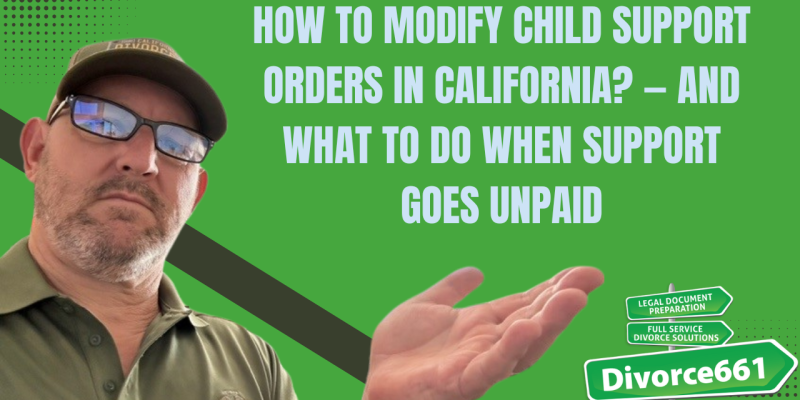How to Modify Child Support Orders in California? — And What to Do When Support Goes Unpaid
I’m Tim Blankenship of Divorce661. In my video I walk through how to handle child support when circumstances change — and what to do when a court-ordered payment isn’t being made. Whether you need to modify an order because your income or custody situation changed, or you need to enforce an existing order after missed payments, here’s a clear, practical guide to protect your child’s financial security.
When can child support be changed or enforced?
There are two related but different problems parents face:
- Modification: You can ask the court to change the amount of child support if there has been a material change in circumstances — for example, a significant change in income, a custody or visitation change, or a new child from another relationship.
- Enforcement: If the other parent is not paying under an existing court order, you can pursue legal enforcement to collect past-due support and make future payments regular.
Both processes require documentation and proper forms, and the court will only act when presented with valid reasons and evidence.
Common legal tools to enforce unpaid child support
If a parent falls behind, the court or the local child support agency can use several enforcement mechanisms to compel payment. These are powerful and commonly effective:
- Filing an enforcement request with the court: This starts the legal process to recover unpaid support. It’s often the first step and can lead to other enforcement remedies.
- Wage garnishment / income withholding: Employers can be ordered to deduct child support directly from the payer’s paycheck — a reliable way to ensure regular payments.
- Property liens: A lien can be placed on real property or other assets, which helps secure the debt and can be enforced upon sale or refinancing.
- Suspension of licenses: Courts or agencies can suspend driver’s licenses, professional licenses, or recreational licenses to pressure compliance.
- Contempt proceedings: For willful nonpayment, the court may hold the payer in contempt, which can result in fines or even jail in extreme cases.
- Interest on unpaid support: Unpaid amounts commonly accrue interest, increasing the urgency to collect arrears.
Real case example: enforcement that worked
Here’s a real outcome I’ve seen: a parent fell six months behind on support. We filed an enforcement request and the court issued a wage assignment (income withholding). The result was steady, on-time payments and restored financial stability for the child. Cases like this show that enforcement tools actually work when applied correctly.
How to get started — practical steps
- Review your child support order: Understand exactly what the order requires, including payment amounts and any provisions about arrears or interest.
- Gather evidence: Collect proof of missed payments, communication attempts, pay stubs, bank records, and any relevant correspondence.
- File the appropriate paperwork: File an enforcement request or income-withholding forms with the court. If you’re seeking a modification, file a request to modify the order and include documentation of the changed circumstances.
- Coordinate with local child support agencies: Many counties have child support enforcement offices that can assist with wage garnishment, locating a payer, and other actions.
- Consider contempt or lien requests if necessary: If nonpayment is willful, ask the court to consider contempt or to place liens on property.
Why professional help matters
Family law paperwork and court procedures can be confusing. Working with a lawyer or a trusted legal service prevents mistakes that delay enforcement or modification. At Divorce661 we run updated child support calculations, prepare and file forms correctly, and help you present the strongest case to the court so your child gets the support they’re owed.
Next steps and resources
If you’re dealing with unpaid child support or think your support order should change because your situation has significantly shifted, don’t wait. Start by reviewing your order and gathering documentation. Reach out to your local child support agency or get professional guidance to prepare paperwork and file the right requests quickly.
For a free consultation and help getting started, visit Divorce661.com. Protect your child’s rights and secure their financial future — you don’t have to navigate this alone.
Conclusion
Unpaid child support can threaten your child’s well-being, but there are effective legal tools available: enforcement requests, wage garnishments, liens, license suspensions, contempt, and interest recovery. With the right evidence, paperwork, and professional guidance, you can compel compliance or obtain a sensible modification when circumstances change. Act promptly to protect your child’s financial security.

